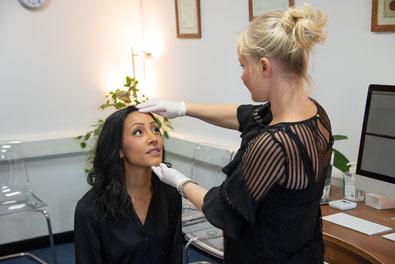Botox (anti-wrinkle) treatment
Botox, is a leading medical and cosmetic treatment. It diminishes wrinkles by temporarily paralyzing muscles. It's injected into specific areas to smooth lines and prevent future creases. Botox is renowned for its effectiveness in reducing facial wrinkles as well as reducing migraines and excessive sweating.
Please note that this page informs you how Botox works and what to expect from a Botox treatment. Prior to any administration a consultation is required to ensure that you are suitable. Botox is not always the most appropriate treatment for your concerns and this will all be discussed at the consultation stage. Botox is a prescription drug.
Where is botox normally injected ?
The three most common areas that patients have treated are the horizontal lines on the forehead, the lines between the eye brows known as the glabella and the area around the outside of the eyes know as the crows feet.
There are also other areas popular areas such as the upper lip to reduce a gummy smile and downturned mouth. The bunny lines around the nose and in the neck bands which is known as the nefertiti neck lift.


Botox - Before & After
The difference between botox and filler
The difference between Botox and filler is in their purpose: Botox targets dynamic wrinkles by relaxing muscles, while filler adds volume to areas like lips or cheeks to smooth lines and enhance contours.
Botox (Dysport,Azzalure,Bocouture)
Botox is the trade / brand name by which Botulinum Toxin A is widely known. It's early dominance (similar in many ways to Hoover) has led to the trade/ brand name becoming the name of the treatment. Other brands such as Dysport, Azzalurre, Bocouture etc are now becoming more prominent.
The Skin Clinic primarily administers Dysport, Azzalure or Bocouture.
Botox has been used for a variety of medical conditions including blepharospasm and muscle spasticity for over 20 years. By using the treatment in the facial muscles and forehead wrinkles are prevented, as they are a direct results of contracting forehead, eye and mouth muscles.
As Botox is a prescription drug, so it CANNOT be advertised in the same way as lip fillers for example. It cannot be mentioned on the front page of a website. Any mention of Botox has to be done in a balanced and factual way. This is why you will see this website regularly referring to anti wrinkle treatments.
Common Botox Treatment Areas:
- Forehead Lines
- Glabellar Lines (Frown)
- Crow’s Feet (side of the eyes)
- Infra-orbital lines (below the eyes – subject to skin condition)
- Peri-oral lip lines (lipstick bleed lines – sometimes combined with dermal fillers)
- Chin puckering
- Nasal flaring
Who should not have botox
- People with infection at the proposed injection site.
- People who have previously had an allergic reaction to Botulinum toxin type A injections.
- People with muscle problems or chronic diseases affecting the muscles, such as Myasthenia Gravis, Eaton Lambert syndrome.
- Children under the age of 18 years.
- Women who are pregnant or breast feeding.
Botox normally takes effect within 3 to 4 days days. Botox injections are not permanent, so we recommend repeat treatments at 3-5 monthly intervals to maintain the effects.
Are there side effects of Botox?
The pain associated with injections is mild and no local anaesthetic is required. The needles used, as can be seen in the video are very fine. It is important to note:
1) You should not lie down for 4 hours after botox injections.
2) No strenuous exercise for 24 hrs after treatment
3) No rubbing or massaging the injected area for 24 hours after the treatment
Otherwise you can engage in all of your usual activities immediately after the injections. You may develop slight bruising at the injection sites, but otherwise there will be no visible signs of the treatment. In rare cases, the botox can migrate to nearby muscles, causing some weakness, such as drooping of the upper eyelid. This is a temporary side effect, lasting for a few weeks at most.
